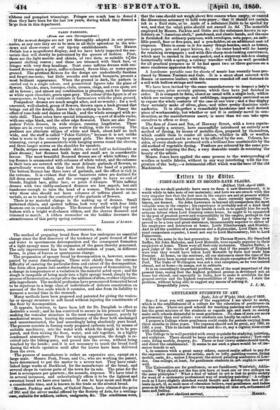PARIS FASHIONS.
(From our own Correspondent.) If the newest designs are not yet thoroughly adopted in our prome- .nades, at any rate they are to be seen in all their splendour in the win- dows and show-rooms of our tip-top establishments. The Mahlon -Delisle has a magnificent display, and we have lately inspected the ma- terials that will shortly be patronised by the queens of fashion. First, there are the light moires and chines, of two tints, so suitable to the present shifting season ; and these are trimmed with black lace, or fringes with very deep headings. Next come taffetas dresses with em- bossed flowers upon a grey, coffee-coloured, flaxen-blue, or water-green ground. The prettiest flowers for the design are undoubtedly fuse.hias and forget-me-nots; but little wreaths and mixed bouquets, present a most brilliant appearance. When the ground is dark, the pattern is carried out in a single colour, and geometrical figures take the place of flowers. Checks, stars, lozenges, clubs, crosses, rings, and even spots, are all in favour; and almost any combination is pleasing, such for instance as white upon chocolate, green upon grey. The colour of the figure is of no consequence, so long as it contrasts or harmonizes with the plain ground.
Pompadour dresses are much sought -after, and no wonder, for a well executed, well-shaded, group of flowers, thrown upon a back ground that brings out all the details, leaves the eye nothing to desire. Fancy the effect of rose-buds and daisies on black, and the whole arranged with ar- tistic skill. These robes have special trimmings,—a sort of double ruche, with one edge black, and the other edge flowered. There are also Pom- padour Pekin dresses, in wide stripes, running lengthwise. These stripes are in every variety, narrow for walking, wide for evening. The prettiest are alternate stripes of white and black, about half an inch wide, and the stuff is called "Pekin Caitiere," because it is not unlike what is worn in the country by peasant girls. The dress requires no trimming, except a passementerie with hanging acorns round the sleeves, and three longer acorns on the shoulder for epaulets.
Plaids, stripes across, and double skirts, are not half so fashionable as plain dresses ; but flounces both large and small are in considerable favour. The most beautiful flounced dresses are of white taffetas ; the top flounce is ornamented with columns of white velvet, -and the columns in their turn are covered with the moat delicate garlands of flowers, so marvellously woven that they look fresh from the hand of a painter. The bottom flounce has three rows of garlands, and the effect is rich in the extreme. It is evident that these luxurious robes are destined for full dress summer toilets, and the corsages ought to have no end of blonde, English lace, pillar lace, or point d'Alencon. White taffetas . dresses with two richly-embossed flounces are less superb, but still handsome enough to turn the head of a woman. There is no reason why these also should not have columns of taffetas placed at in- tervals, so as to break the continuity of the garlands of flowers. There is no material change in the making up of dresses. Small patterned chines, and spotted taffetas, look very well with four little flounces out in rounded scollops. The flounces should be edged top and bottom with a bright well-chosen ribbon, and the sleeves flounced and trimmed to match. A ribbon stomacher on the boddice increases the attractiveness of this pretty spring costume.
LEONIE VAUNET.


























 Previous page
Previous page